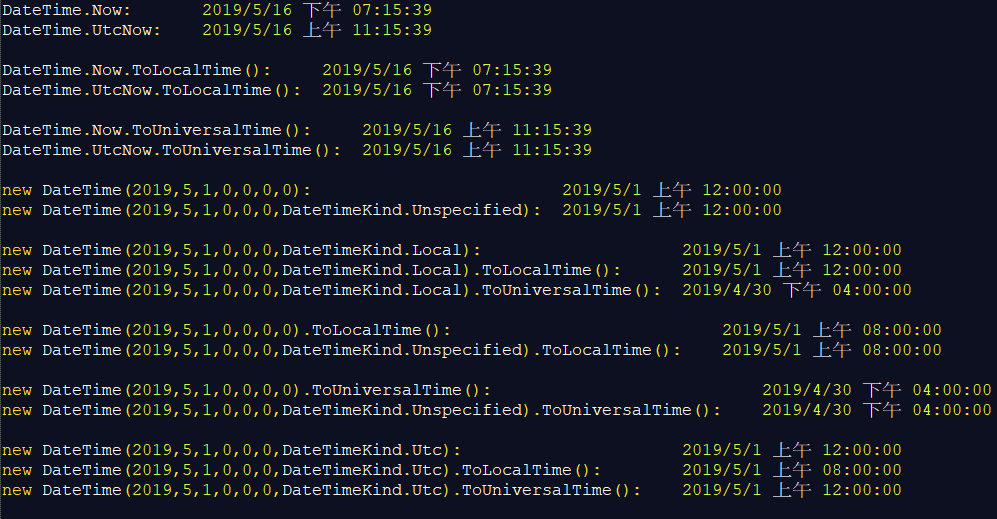.NET DateTime:
StringBuilder log = new StringBuilder();
log.Append("DateTime.Now:\t").Append(DateTime.Now).AppendLine();
log.Append("DateTime.UtcNow:\t").Append(DateTime.UtcNow).AppendLine().AppendLine();
log.Append("DateTime.Now.ToLocalTime():\t").Append(DateTime.Now.ToLocalTime()).AppendLine();
log.Append("DateTime.UtcNow.ToLocalTime():\t").Append(DateTime.UtcNow.ToLocalTime()).AppendLine().AppendLine();
log.Append("DateTime.Now.ToUniversalTime():\t").Append(DateTime.Now.ToUniversalTime()).AppendLine();
log.Append("DateTime.UtcNow.ToUniversalTime():\t").Append(DateTime.UtcNow.ToUniversalTime()).AppendLine().AppendLine();
log.Append("new DateTime(2019,5,1,0,0,0,0):\t").Append(new DateTime(2019, 5, 1, 0, 0, 0, 0)).AppendLine();
log.Append("new DateTime(2019,5,1,0,0,0,DateTimeKind.Unspecified):\t").Append(new DateTime(2019, 5, 1, 0, 0, 0, DateTimeKind.Unspecified)).AppendLine().AppendLine();
log.Append("new DateTime(2019,5,1,0,0,0,DateTimeKind.Local):\t").Append(new DateTime(2019, 5, 1, 0, 0, 0, DateTimeKind.Local)).AppendLine();
log.Append("new DateTime(2019,5,1,0,0,0,DateTimeKind.Local).ToLocalTime():\t").Append(new DateTime(2019, 5, 1, 0, 0, 0, DateTimeKind.Local).ToLocalTime()).AppendLine();
log.Append("new DateTime(2019,5,1,0,0,0,DateTimeKind.Local).ToUniversalTime():\t").Append(new DateTime(2019, 5, 1, 0, 0, 0, DateTimeKind.Local).ToUniversalTime()).AppendLine().AppendLine();
log.Append("new DateTime(2019,5,1,0,0,0,0).ToLocalTime():\t").Append(new DateTime(2019, 5, 1, 0, 0, 0, 0).ToLocalTime()).AppendLine();
log.Append("new DateTime(2019,5,1,0,0,0,DateTimeKind.Unspecified).ToLocalTime():\t").Append(new DateTime(2019, 5, 1, 0, 0, 0, DateTimeKind.Unspecified).ToLocalTime()).AppendLine().AppendLine();
log.Append("new DateTime(2019,5,1,0,0,0,0).ToUniversalTime():\t").Append(new DateTime(2019, 5, 1, 0, 0, 0, 0).ToUniversalTime()).AppendLine();
log.Append("new DateTime(2019,5,1,0,0,0,DateTimeKind.Unspecified).ToUniversalTime():\t").Append(new DateTime(2019, 5, 1, 0, 0, 0, DateTimeKind.Unspecified).ToUniversalTime()).AppendLine().AppendLine();
log.Append("new DateTime(2019,5,1,0,0,0,DateTimeKind.Utc):\t").Append(new DateTime(2019, 5, 1, 0, 0, 0, DateTimeKind.Utc)).AppendLine();
log.Append("new DateTime(2019,5,1,0,0,0,DateTimeKind.Utc).ToLocalTime():\t").Append(new DateTime(2019, 5, 1, 0, 0, 0, DateTimeKind.Utc).ToLocalTime()).AppendLine();
log.Append("new DateTime(2019,5,1,0,0,0,DateTimeKind.Utc).ToUniversalTime():\t").Append(new DateTime(2019, 5, 1, 0, 0, 0, DateTimeKind.Utc).ToUniversalTime()).AppendLine().AppendLine();
WriteLog(log.ToString());
Result:



